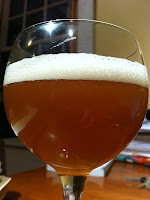 out the specialty grain from his recipe, though, and went straight Vienna. And, in keeping with the Franco-Belgian theme (maltster, not malt itself, wise-acre), I’ll be pitching a left-over mason jar of Wyeast 3522 Belgian Ardennes from my recent yeast experiment schenanigans. The hopping, though, is pretty much straight American. We’ll just call this beer stylistically awkward, and leave it at that. Just like puberty, huh?
out the specialty grain from his recipe, though, and went straight Vienna. And, in keeping with the Franco-Belgian theme (maltster, not malt itself, wise-acre), I’ll be pitching a left-over mason jar of Wyeast 3522 Belgian Ardennes from my recent yeast experiment schenanigans. The hopping, though, is pretty much straight American. We’ll just call this beer stylistically awkward, and leave it at that. Just like puberty, huh?
124. Vienna Pale Ale
Mash:
10 lbs. MFB Vienna Malt
Mash @ 154° F for 60 minutes w/ 3 ½ gallons of RO water & 2 g. gypsum; collected 2 ¼ gallons @ 1.074
Batch sparge @ 166° F for 20 minutes w/ 3 ½ gallons RO water & 2 g. gypsum; collected 3 ¼ gallons @ 1.026
Collected 5 ½ gallons; added ½ gallon to bring to 6 gallons, brought to a boil (60 minutes), & added:
w/60 to go: 1 oz Chinook leaf 11.3% AA
w/20 to go: 1 oz. Amarillo leaf 10.7% AA
w/15 to go: 1 tsp. Irish Moss
w/10 to go: 1 oz. Centennial leaf 11.5% AA
w/5 to go: 1 oz. Amarillo leaf 10.7% AA
w/0 to go: 1 oz. Citra leaf 13.4% AA
Chilled, racked to carboy, & pitched mason jar of Wyeast 3522 Belgian Ardennes from 122. American Pale Ale Yeast Experiment
Brewed: 8/11/2012
Secondary: 9/1/2012 @ 1.012; dry hop w/ 1 oz. Citra leaf 13.4% AA
Bottled: 9/22/2012 w/ 3 oz. table sugar
OG: 1.052
FG: 1.012
Tasting Notes (2/21/2013): This beer was an experiment to see how a pale ale made with all Vienna malt turned out. And the answer is pretty darn good. While it is currently a bit long in the tooth, is still holds together pretty well—the hop flavor has receded, but the overall beer is still pleasant with a lightly doughy and chewy body. The beer pours a dusky and lightly hazy gold with a thin but persistent white head that does lace the glass nicely. It is also lively in the
 glass—lots of small, tight bubbles dancing around. The Centennial is still
evident in the nose; there is a sour, mineral tang along with some dry
spiciness and soft floral lemon, which is the Citra and maybe some of the
Amarillo. The Chinook is surprisingly absent in the nose, although there is a
touch of the harsher Chinook bitterness that lingers in the finish. There is
also sweet candy and bread dough from the malt that blends and holds up the hop
aromas. Flavors open with a spicy sour resin hop tang coupled with bread dough
and a touch of creaminess; the bitterness picks up in the middle, and is dry
and mineral-tinged, while the finish is lightly caramel sweet with lingering
bitterness that is harsher than that in the middle. There is also a touch of
pine hop flavor in the finish that works well; it comes across almost as
alcohol heat, but I think that is the trademark Chinook harsh bitterness
putting its two cents in. The body is light to medium, with the bitterness and
carbonation lightening the beer as a whole on the palate. As a whole, a solid
beer—this is an idea worth pursuing further, although I would swap out the
Chinook for something like Magnum to see if that created a cleaner, easier
finish. I will say that while there is some roughness in the lingering
bitterness, it does fit with the beer profile. Beer, why are you so
delightfully good?
glass—lots of small, tight bubbles dancing around. The Centennial is still
evident in the nose; there is a sour, mineral tang along with some dry
spiciness and soft floral lemon, which is the Citra and maybe some of the
Amarillo. The Chinook is surprisingly absent in the nose, although there is a
touch of the harsher Chinook bitterness that lingers in the finish. There is
also sweet candy and bread dough from the malt that blends and holds up the hop
aromas. Flavors open with a spicy sour resin hop tang coupled with bread dough
and a touch of creaminess; the bitterness picks up in the middle, and is dry
and mineral-tinged, while the finish is lightly caramel sweet with lingering
bitterness that is harsher than that in the middle. There is also a touch of
pine hop flavor in the finish that works well; it comes across almost as
alcohol heat, but I think that is the trademark Chinook harsh bitterness
putting its two cents in. The body is light to medium, with the bitterness and
carbonation lightening the beer as a whole on the palate. As a whole, a solid
beer—this is an idea worth pursuing further, although I would swap out the
Chinook for something like Magnum to see if that created a cleaner, easier
finish. I will say that while there is some roughness in the lingering
bitterness, it does fit with the beer profile. Beer, why are you so
delightfully good?

No comments:
Post a Comment